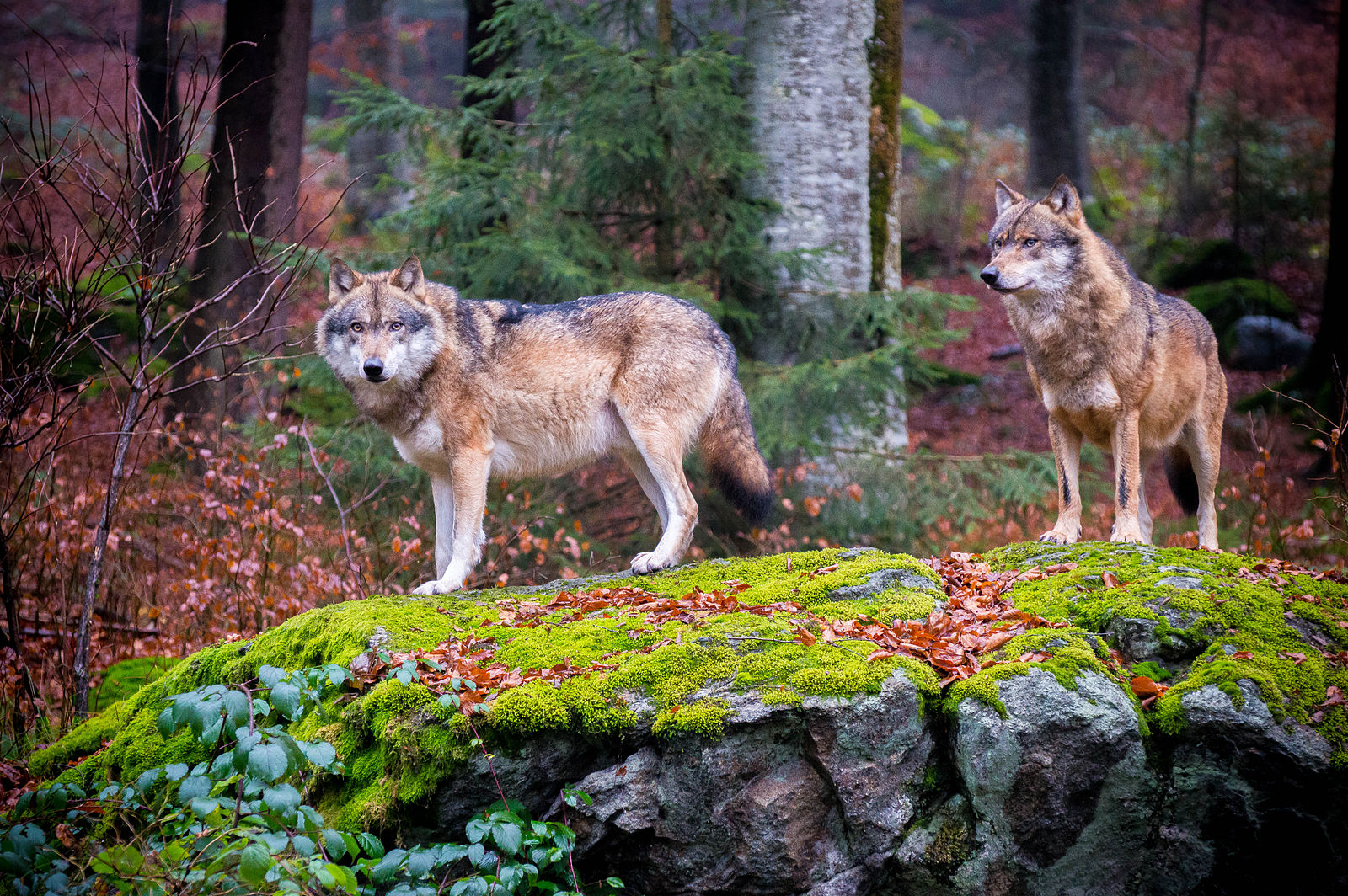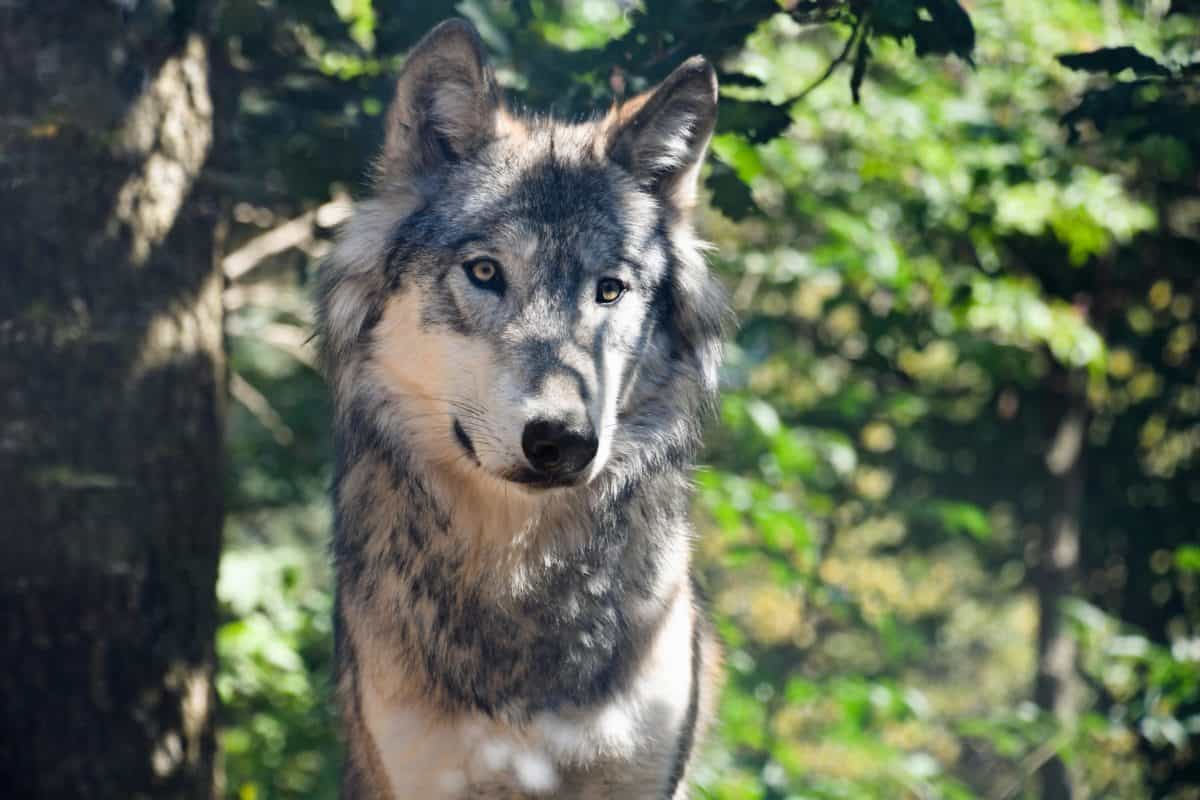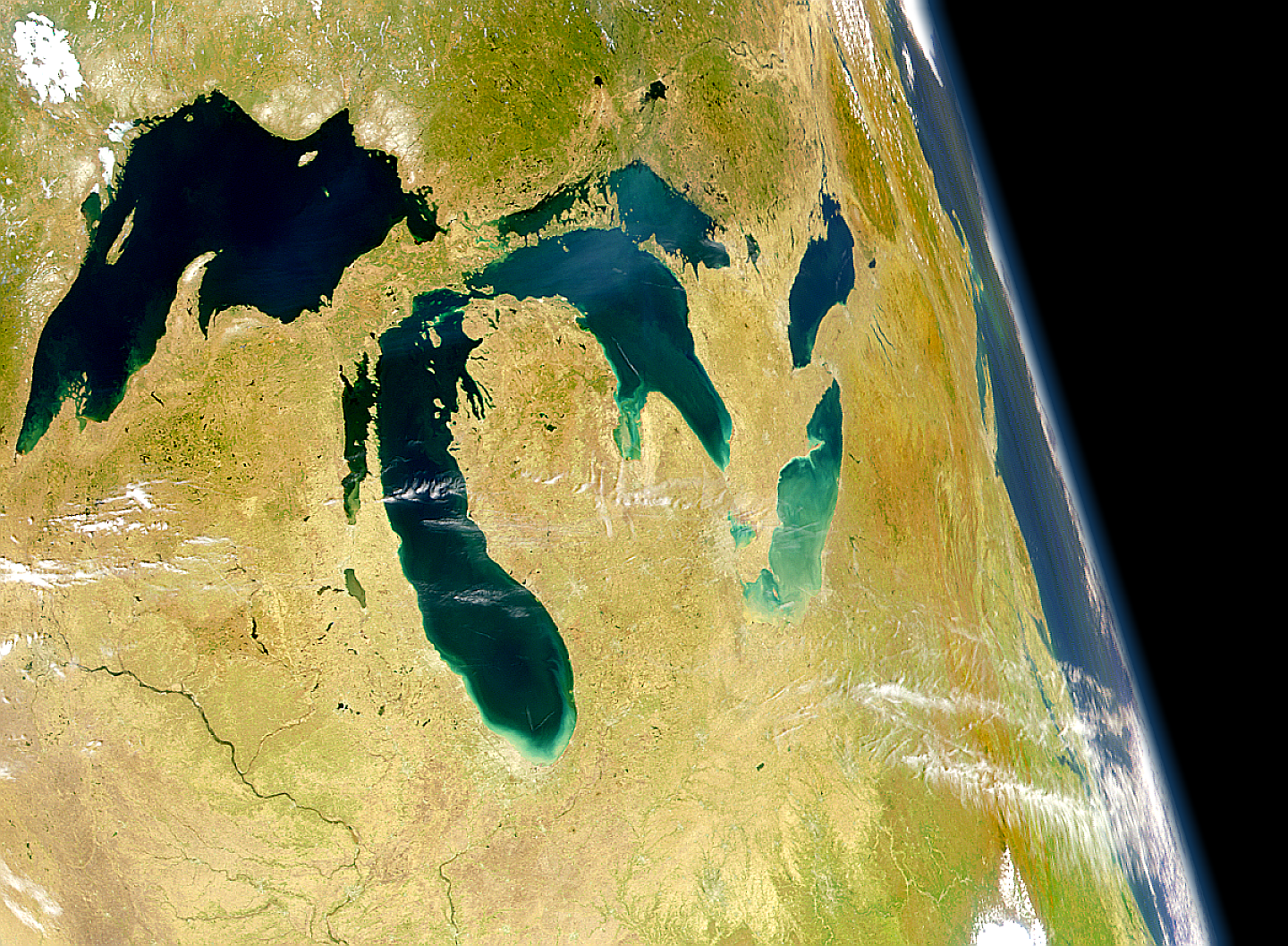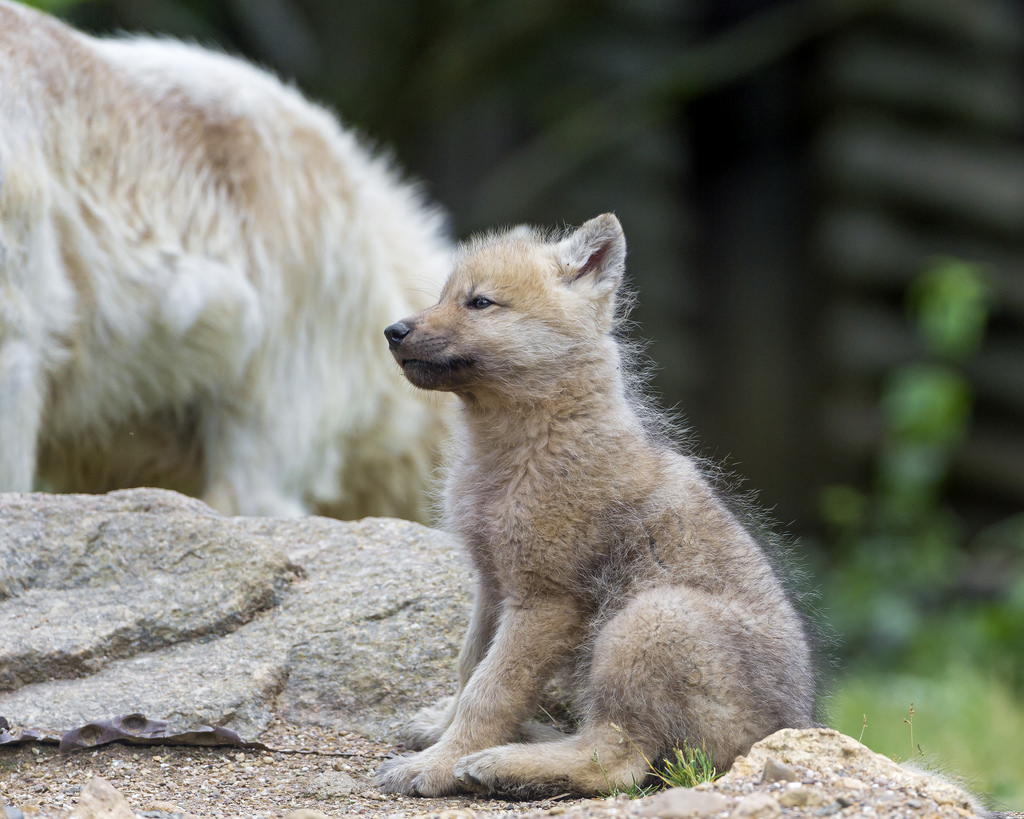
Wolves are incredibly important animals to the ecosystems they live in, including Wisconsin’s forests. Wolves keep our forests healthy by helping to control deer populations and by culling sick animals, like deer with chronic wasting disease. Wolves have even been called the immune system of the forest because they winnow the sick animals and help restore some landscapes by reducing the number of animals that graze and kill trees and shrubs. You can learn more about the impact of deer on forests here.
Additionally, wolves are considered important to many Tribes. According to the Great Lakes Indian Fish and Wildlife Commission, “ Wolves are revered as relatives in the Ojibwe lifeway. Ma’iingan [the Anishinaabe word for wolves] serves as a clan icon—a representation of traditional governance and organization within the community.” Within the Bad River Reservation, they are listed as a ‘Tribally Protected Species”.
Historically, the wolf population was desecrated, earning them a spot on the Endangered Species Act list (ESA). There have been a lot of attempts to remove them from the ESA. In 2011 the State Legislature passed a law that says if wolves are removed from the Endangered Species, there must be a wolf harvest (hunt) between November and February. This undermines the DNR’s authority and the process they are expected to follow before moving forward with a hunt.
No wolf hunt should occur until the DNR is able to update the State Management Plan through on an inclusive, equitable, fair, and science-based planning process that includes:
-
A review of most current science, including information about the extinction crisis and social science with updated public polling
-
Full consultation of the Tribes
-
A public input process
-
Broad consultation of stakeholder groups
The Trump administration moved to remove wolves from the Endangered Species list in October. Here is a timeline of events that have occurred since then:
-
October 2020- Trump Administration finalized a rule to start taking steps to remove Endangered Species protections (read more here)
-
November- Sierra Club and partners announced plans to challenge the removal of gray wolves from the ESA (read more here)
-
January- the removal of grey wolves from the Endangered Species list becomes official. Sierra Club moves our lawsuit forward
-
January-
-
The Natural Resources Board (NRB) hosted a hearing about whether to open a wolf hunt (learn more here). The majority of comments opposed a wolf hunt and called for a thoughtful process with full consultation of the Tribes. (You can watch the hearing here)
-
After listening to hours of testimony, the NRB announced they would not pursue a hunt until November.
-
February- Trophy hunting organization, Hunter Nation, successfully sued the NRB and Department of Natural Resources (DNR) to force a wolf hunt.
-
A week-long wolf hunt kicked off on February 22, with a quota of 119 wolves and roughly ten times that number of permits.
-
In less than three days, the wolf hunt exceeded the quota by 82% and the DNR closed the hunt. Additionally, Wisconsin is the only state to allow wolves to be killed using dogs, which results in many heinous practices.
To learn more about our work to protect wolves and our Wildlife Team, watch the video with Wildlife Team leader, Diane Cain.
Why should we protect the wolves of Wisconsin?
1) Wolves help our forests. Ecosystems function as complex webs of interrelated species that rely on each other to survive. Much like a house of cards or a tower of Jenga blocks, if one piece is removed,there can be far-reaching and devastating consequences — whole ecosystems can even come toppling down. Wisconsin’s forests are no different — healthy forests rely on apex predators, like wolves, to manage the populations of deer and other herbivores. When there are too many deer, like in Wisconsin, they overgraze on growing trees and saplings. Overconsumption prevents the saplings’ maturation into larger trees and thus harms the health of Wisconsin’s forests. Without predators, rampant deer overpopulation can lead to a 40% decline in plant species — especially of certain trees that they prefer to eat, like hemlock and cedar. In Northern Wisconsin, researchers found deer are limiting tree regeneration in 8 out of 10 of the tree types studied.

Wolves act to control this unchecked deer population, thereby promoting healthy trees and encouraging forest maturation. Additional benefits include increased biodiversity, ecosystem stability, less flooding, less disease, and less erosion. But wolves don’t just limit the deer population — they also change deer behavior. Deer must become more cautious and vigilant in the presence of wolf populations, meaning they move more frequently, avoid certain areas, and graze less intensely but more diffusely. This behavior modification results in less damage to trees and plants. In this way, wolves act as the protectors of our forests, and we must protect them in turn.
2) Wolves improve our health and safety. Rodents and deer contribute to the spread of several diseases in Wisconsin, including Lyme disease and chronic wasting disease (CWD). There are more than 4000 cases of Lyme disease in humans each year in Wisconsin, making the state one of the epicenters of the potentially deadly tick-borne illness. Since wolves limit rodent populations, as well as deer populations, they help prevent the spread of Lyme disease. Chronic wasting disease is also rising in Wisconsin, an invariably deadly neurological illness in deer that’s related to Mad Cow Disease. While no humans have been infected yet, there is the potential for the disease to cross the species barrier. Wolves represent a potential solution to this ailment as well, since they target weak and sickly animals to eat, reducing the spread of the disease.
 Auto collisions with deer lead to about 1.3 million accidents and 200 deaths in the United States each year — also in large part due to deer overpopulation. In Wisconsin, where deer crashes are even more common, 1 in 72 drivers will hit a deer each year. Again, protecting wolves will lead to a reduction in deer populations, resulting in less accidents and safer travels.
Auto collisions with deer lead to about 1.3 million accidents and 200 deaths in the United States each year — also in large part due to deer overpopulation. In Wisconsin, where deer crashes are even more common, 1 in 72 drivers will hit a deer each year. Again, protecting wolves will lead to a reduction in deer populations, resulting in less accidents and safer travels.
Contrary to popular myths, wolves generally do not pose a danger to humans. Wolves seek to avoid people, and wolf attacks are extremely rare — there have only been two confirmed fatal wolf attacks in the wild in North America ever, despite much contact and 77,000 wolves living here. And it’s never happened in Wisconsin. To put things in perspective, each year dogs bite 4 million people in the United States alone, resulting in approximately 10,000 hospitalizations. From 1979 to 2005, they’ve killed 19 people. Wolves, on the other hand, are relatively much safer.
3) Wolves boost our economy. Wolves increase forest growth, and forests and parks increase tourism, promote jobs, generate economic activity, fund the government, and boost property values. They also help reduce the costly expenses of limiting the spread of Lyme disease and chronic wasting disease. Since deer-auto collisions result in upwards of $60 million in property damage each year, wolves will cut down on that cost as well.
4) We must respect tribal rights. Wolves are an important animal for many Native Americans in Wisconsin and particularly to members of the Lake Superior Chippewa Bands in Wisconsin. The Great Lakes Indian Fish and Game Commission, which represents 11 tribes of the Anishinaabe (also known as the Chippewa or Ojibwe) in the Midwest, opposes opening hunt on wolves. Based on survey results, Native Americans in Wisconsin are much more likely to hold positive views of wolves, favor protective policies for them, and oppose wolf hunting. Since these tribes were granted rights to hunt, fish, and gather on their lands in northern Wisconsin, where most Wisconsin wolves are located, we must also respect their wishes in this area.
What can we do to protect these wolves?
Here are some crucial policies Wisconsin needs to implement to responsibly increase and maintain our wolf populations:
1) Form a Regional Wolf Management Group. Wisconsin must team up with neighboring Great Lakes states and provinces to manage these wolf populations. State lines and borders mean nothing to wolves, and policy in one state affects the wolves in neighboring states. A regional wolf management agency would serve to better coordinate between federal, state, and tribal agencies, as well as with stakeholders, researchers, nonprofits, and NGOs.
 2) Create a Western Great Lakes bio-reserve. The entire north woods ecosystem spanning large swaths of northern Minnesota, Wisconsin, and Michigan would benefit from being collectively designated asa bio-reserve. Not only would this make its management more efficient, but it would help to connect and grow these currently splintered forests. It will promote the return of old growth forests, increase bio-diversity, and restore and preserve a fully-functioning and sustainable ecosystem for generations to come. We can also connect currently separated regions by creating wildlife corridors that will enhance the free movement of animals, promote genetic exchange, and reduce fragmentation.
2) Create a Western Great Lakes bio-reserve. The entire north woods ecosystem spanning large swaths of northern Minnesota, Wisconsin, and Michigan would benefit from being collectively designated asa bio-reserve. Not only would this make its management more efficient, but it would help to connect and grow these currently splintered forests. It will promote the return of old growth forests, increase bio-diversity, and restore and preserve a fully-functioning and sustainable ecosystem for generations to come. We can also connect currently separated regions by creating wildlife corridors that will enhance the free movement of animals, promote genetic exchange, and reduce fragmentation.
3) Draft a new management plan informed by conservation biology. The current management plan from 1999 that recommends only 350 wolves is outdated and poorly thought out, making it ill-equipped to benefit this ecosystem. It failed to consider population genetics, predator-prey ratios, and the full extent of a wolf-triggered trophic cascade, so it greatly underestimates the size of the wolf population able to live here. A new committee of scientists must reassess the region’s carrying capacity for wolves, taking into consideration public tolerance as well as their role in maintaining healthy forests.
4) Eliminate the potential for wolf hunting. Currently, gray wolves are federally protected under the Endangered Species Act, making it illegal to hunt them in Wisconsin. But if their federal status were to change — which is a real possibility — they could be hunted and killed for sport, and their numbers could drop to dangerously low levels. Therefore, to further protect this essential species, we must repeal 2011’s Act 169, which would call for a wolf hunting season in Wisconsin if their federal protections were revoked. In addition, a law explicitly prohibiting wolf hunting and trapping is necessary to prevent the destabilizing effects of poaching them. This policy must be strictly enforced as well — with potential fines and jail time to send a message to poachers.
Land and livestock owners that have legitimate wolf conflicts can apply for permits to reasonably and humanely manage wolves on their private property — but mandatory reporting would be required. Funds should be designated to assist land owners to protect their livestock with fencing and other measures, which would prevent unnecessary wolf conflicts.
5) Implement wolf-related education and outreach. Wisconsin should conduct public opinion surveys to gauge our residents' attitudes surrounding wolves. We must develop media campaigns to spread  awareness of wolves’ benefits for Wisconsin, as public support for these programs is crucial to their success and implementation.
awareness of wolves’ benefits for Wisconsin, as public support for these programs is crucial to their success and implementation.
Livestock owners and farmers should be educated on proper animal husbandry and predator management techniques, with an emphasis on prevention as opposed to reparations. We must increase funding for fencing, hazing, electronics, flagging, and other measures to reduce conflicts, as well as for research to develop other effective strategies for wolf conflict de-escalation. Non-cooperative livestock owners should not be compensated for livestock loss or granted wolf kill permits.
6) Mandate the consultation with tribal leaders for future projects. We must respect native soverigenty. Before any construction projects or development, Wisconsin officials must consult with the tribes and allow for their input and influence. Biodiversity must also be taken into consideration for future projects to avoid fragmentation resulting from roadways and encourage connectivity.
7) Translocate wolves to areas that would benefit from a greater wolf presence. We must conduct studies to determine which forests in Wisconsin and elsewhere would benefit from wolves. Specifically, the Manistee and Huron forests of the lower peninsula of Michigan are prime areas for wolf reintroduction. To prevent conflicts, the federal government should oversee and facilitate this translocation, while respecting tribal rights.
If you'd like to get involved in protecting Wisconsin's environment (and wolves), come volunteer with us!
Adapted from “An Envisioned Future for Wisconsin Wolf Stewardship Policy and the North Woods Bio-region” by Bob Boucher, Sierra Club